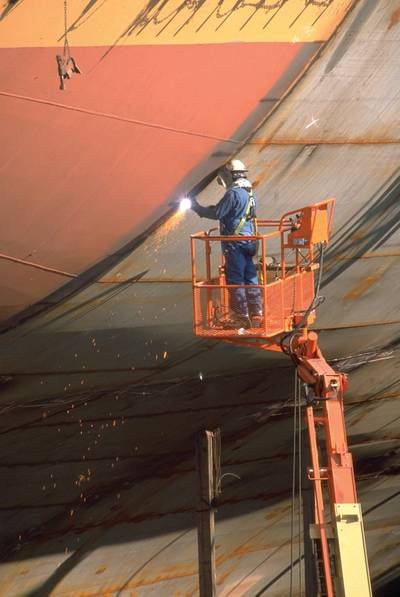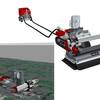The Lowdown on Lifting
Telehandlers and aerial work platforms (AWPs) have long been staples of the construction industry, favored by contractors for their safety and efficiency when working at height. As the equipment evolves, these machines are becoming more versatile and moving into other industries, including the marine market. Telehandlers allow for flexibility in handling goods and materials, particularly in shipyards and shipyard warehouses, fabrication facilities and workshops, and AWPs provide a safe, efficient way to work at height in these same settings.
Telehandlers are material handling vehicles with telescoping booms that allow them to deliver materials to heights of 65 ft. or more. The reach and load capacities separate these machines from forklifts, which rely on a vertical mast to move loads, and wheel loaders equipped with forks. Telehandlers can carry loads of 75,000 pounds or more, well above a typical shipyard load of 10,000 to 15,000 pounds. Compact telehandlers, as the name implies, have smaller dimensions than traditional telehandlers and are well suited to close quarters. They offer tight turning radii and low profiles for outstanding maneuverability in confined spaces, such as indoor shipbuilding and repair facilities or crowded warehouses. Despite their reduced size, compact telehandlers typically offer lift heights up to 18 ft., outreach up to 11 ft., and carrying capacities up to 5,500 pounds.
Telehandler Accessories Enhance Versatility
A variety of attachments that fit on the end of the telehandler boom enhance the versatility and performance of the machines. Fork carriages come in a variety of widths and can offer many degrees of freedom, including rotation and side tilt. The carriages can be equipped with numerous fork options to accommodate any size load. Truss booms offer a means to move suspended loads and heavy, bulky materials, including I-beams used in ship building.
Sheet material adapters enable operators to move large, flat materials, such as drywall or plywood. This accessory limits damage during transport and can be used with pallet or lumber forks and carriages to pick and place materials. Carriages come in a variety of widths and fork lengths to accommodate the dimensions of a load.
While AWPs are still the best way to move people to work at height, telehandler booms can also be outfitted with work platforms to lift people. Bucket attachments allow telehandlers to scoop and carry large volumes of loose materials or waste. To tackle larger tasks, a grapple bucket features a hydraulic grapple arm that clamps down to grab bulky materials and secure the load.
AWPs Move People and Materials
The job of AWPs is to safely place people and materials in hard-to-reach spaces that might otherwise be inaccessible. Their reach and capacity, particularly when there is a need for two workers with tools in the platform, allow these machines to facilitate a wide variety of work, such as welding, sandblasting and painting in ship building and maintenance. Shipyard operators in the market for an AWP will find a variety of options available to them with a variety of power sources, functions and reach capabilities. Smaller, more compact boom lifts are usually powered by rechargeable batteries. They operate quietly without any exhaust, making them the boom of choice for indoor applications, including metal fabrication and carpentry workshops and offices that are often part of a shipyard. Larger combustion-powered booms use gas or diesel fuel, offer platform heights as high as 185 ft., and lend themselves to outdoor applications.
AWPs also vary by configuration. Scissor lifts use a crisscross support to lift the work platform. These machines work well for applications that require access directly overhead, such as maintenance or repair. Telescopic booms use hydraulic cylinders to extend straight out from the base, like a telescope, and can rotate 360 degrees. Articulating boom lifts employ a joint or knuckle that enables the boom to bend and reach up, over, and sometimes even around obstacles. Like telescopic boom lifts, they rotate 360 degrees, but their horizontal reach is not as great. They tend to be more compact and can be electric- or combustion-powered.
A mast boom uses a jib to reach up and over obstacles, but this AWP can work in tighter spaces than an articulating boom. Mast booms lend themselves to shipyard warehouses, where they can be used to reach high shelving or change light bulbs and perform other maintenance tasks.
A Size for Every Job
AWPs are available in a variety of sizes. As is the case with compact telehandlers, low-level AWPs are becoming more popular. Personal and portable lift devices in heights up to 20 feet offer a safe alternative to ladders and scaffolding. To use a ladder correctly, a worker is required to maintain three points of contact. This leaves just one hand free to perform a task. Using a lift enables a worker to stand in a platform – safely tied off and surrounded by railing – with two free hands and space for tools and materials. Scaffolding is stationary, making it difficult to quickly move through a shipyard. In addition, scaffolding takes time to erect and tear down, which is time saved using an AWP.
At the other extreme, the largest AWPs can reach as high as 185 ft. (or 19 stories) and provide access to more than three million cubic feet of reachable space. By including a telescopic jib, the unit can extend and retract to provide additional reach, up-and-over capability, and the ability to telescope into and around ships in a variety of applications.
The versatility of both telehandlers and AWPs means maritime companies typically find multiple uses for the machines on ce they are onsite – uses that often go beyond the original reasons for bringing a machine to a shipyard. In the maritime industry, versatility translates to productivity. As important, selecting the right machine to work at height or move materials ensures crew safety. That will deliver the peace of mind that accompanies a job well done.
Brian Boeckman is the Global Product Director for telehandlers at JLG Industries, Inc., responsible for worldwide management of the company’s full line of telehandling equipment, which is sold under the JLG, SkyTrak, and Deutz Fahr brands.
Jeff Ford is Global Product Director for aerial work platforms at JLG Industries, Inc., responsible for managing and growing the company’s aerial work platform lines, working with the product development and product management teams.
(As published in the August 2014 edition of Maritime Reporter & Engineering News - http://magazines.marinelink.com/Magazines/MaritimeReporter)















